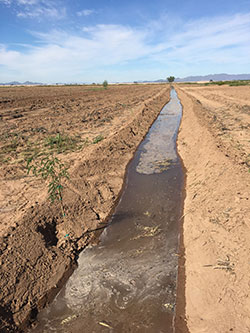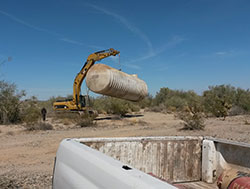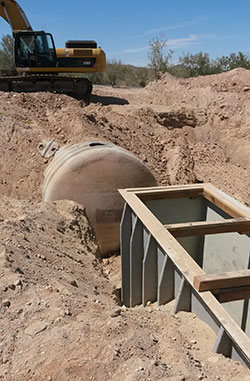
Preparing to plant 350 Mesquite trees at the Palo Verde Ecological Reserve.

A 10,000 gallon water storage tank before installation.

Water storage tank, and drinker box, during installation.
Richard Francis is a wildlife habitat supervisor for CDFW’s Inland Deserts Region. He’s based in Blythe, in eastern Riverside County near the California/Arizona state line. He was raised in the city of Corona, also in Riverside County, where he graduated from high school. As a young man Richard was anxious to have a career involving the outdoors, which is how he ended up working at a ski lodge in Mammoth, before spending 25 years as a fishing guide on the Colorado River, just south of Hoover Dam and Lake Mead. His love of the outdoors finally led him to CDFW in 2005 where he became a seasonal aide, then a technician, and eventually a wildlife habitat supervisor.
What does your job as a wildlife habitat supervisor entail?
I’m in charge of fish and wildlife technician seasonal aides, managing properties and making decisions on what to do with those properties. A large part of my job is creating food plots and habitat for wildlife. That means planting trees, growing food, putting in riparian habitat, and taking out invasive species and noxious weeds and replacing them with native plants and animals to create better habitat for wildlife. I have a few other duties, like habitat restoration along the Colorado River.
Much of the work we do is of direct benefit to hunters. Blythe has a good population of mule deer, and this is one of the premier white-winged and mourning dove hunting areas in the United States. We also have 60 acres of wetlands for waterfowl hunting. We plant those ponds with Japanese millet, which is basically a weed and can get up to 6 feet tall. It’s used for both waterfowl habitat and as a food source.
Why did you make the jump from being a licensed hunting and fishing guide to working for a fish and wildlife conservation agency?
It sounds kind of crazy to leave that because I really enjoyed guiding and helping people learn about hunting, fishing and conservation of our unique desert fish and wildlife, but it was time to grow up! There were some things missing in my life, like a monthly check. It’s very unusual but I’m one of few people in this work without a college degree. I believe I was hired because of my knowledge of fish and wildlife habitat, and because I have experience in the operations of farm equipment and farming practices.
Can you describe the property where your work takes place?
Our main focus is the Palo Verde Ecological Reserve. It’s farmland purchased in 2005 and consists of two units. One is north of Blythe and is approximately 1,500 acres that are planted in cottonwood and mesquite trees. Two hundred of those acres have been set aside for waterfowl and upland game bird hunting. The newest property, purchased in 2017, is approximately 400 acres of farmland, also in the Blythe area. It’s currently planted in wheat and 400 mesquite trees. The wheat will be cut weeks prior of opening of the first dove season, Sept. 1, and will be open throughout the entire upland season. Our game species include white-winged dove, mourning dove, Eurasian-collared dove, Gambel’s quail and rabbits. All are available for hunting on this property.
What’s a typical day for you?
It depends on the season. In the wintertime we irrigate duck ponds and clear the ditches of invasive species. We disc and plant wheat fields for our upland game bird program. We plant the wheat in the winter, and we irrigate and farm it like a crop, but we mow it rather than harvest it. When we mow it down, it attracts doves for dove hunting. It feeds everything – the deer love it. In the springtime we do a little bit of monitoring of the deer population and waterfowl. Monitoring in our area is done by visual surveys and game cameras placed in strategic high traffic locations. The cameras are checked on a monthly basis. Then in the summer, as the heat comes, we spend more time out in the desert. We have a series of wildlife drinkers that CDFW has installed to provide water for wildlife species in the hottest part of the year. We have to go out and do maintenance on those and make sure they’re full of water. If the water levels get low, we haul water into the desert and fill them up, and that happens all summer long.
Why is it important for CDFW to create and fix habitat, as opposed to allowing habitat to be created naturally?
It’s best to keep invasive stuff at bay, to keep areas like they were. We keep the noxious weeds out of there, and the native plants come back and the wildlife will follow. In the ’80s, the population of waterfowl (Canadian geese and duck) were in the hundreds of thousands. Then the numbers dropped off for no obvious reason. We believe they’re coming back now because we got rid of the salt cedars and phragmites (non-native reed or wetland grass) and replaced them with huge cottonwood and mesquite groves.
When the Palo Verde Ecological Reserve was established, there was a healthy population of desert mule deer living among mesquite on farmland across the river in Arizona. Now that our trees are grown, we see the deer swim back and forth to live among the mesquite, cottonwood, and giant willows that we planted. In a single day we might see 75 deer in the open and many more within the trees, where they take advantage of the cover.
What projects have you worked on that you’re the most proud of?
Installing and maintaining the wildlife drinkers is some of the hardest work I’ve done. A drinker is a 10,000 gallon underground storage tank with a drinker box connected to it. There’s a dam built uphill from the storage tank, so when it rains, the water collects and fills the storage tank. If the conditions are right in the desert, they can stay full for a long time but they often need maintenance or refilling in July or August. That’s really hard work because we sometimes need heavy equipment like excavators, up in the mountains to get it done. We have to keep a level head and work well together because it’s hot, exhausting and can be dangerous. But it’s rewarding to know the work will enable important species, like bighorn sheep and deer to survive. We also put in small-game drinkers for the birds that live in the desert.
How bad are the weather conditions?
Come July and August it will be up to 115 degrees in the desert and the humidity can make it feel like it’s 125. On those days, your time outside is very limited. You have to be finished by noon or 1 p.m. so we start at 5 a.m. or earlier, depending on what we’re doing that day. If we’re working way out in the desert checking drinkers, we might leave at 3:30 or 4 a.m. just to avoid the heat.
If you weren’t doing this – if jobs working with wildlife and the great outdoors didn’t exist – what else would you be doing?
Fishing and hunting mostly! Or maybe I’d be an executive chef at my own restaurant. It’d be a barbecue restaurant. My specialty is everything – brisket, ribs, pork butts. But I have 15 years in at CDFW. Though l can retire at 20 years, if they’ll have me I’d be happy to stay. I love this job. It’s awesome – I’m blessed.
CDFW photos. Top Photo. Richard Francis, in a wheat field at the Palo Verde Ecological Reserve.